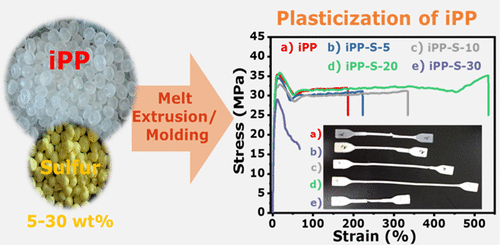当前位置:
X-MOL 学术
›
Ind. Eng. Chem. Res.
›
论文详情
Our official English website, www.x-mol.net, welcomes your
feedback! (Note: you will need to create a separate account there.)
Polypropylene–Elemental Sulfur (S8) Composites: Effect of Sulfur on Morphological, Thermal, and Mechanical Properties
Industrial & Engineering Chemistry Research ( IF 3.8 ) Pub Date : 2020-06-30 , DOI: 10.1021/acs.iecr.0c01687 Vijay S. Wadi 1 , Kevin Halique 1 , Saeed M. Alhassan 1
Industrial & Engineering Chemistry Research ( IF 3.8 ) Pub Date : 2020-06-30 , DOI: 10.1021/acs.iecr.0c01687 Vijay S. Wadi 1 , Kevin Halique 1 , Saeed M. Alhassan 1
Affiliation

|
Sulfur-rich polymers have attracted many researchers in recent years because of their low cost and broad range of applications. However, direct utilization of elemental sulfur in preparing advanced materials is limited due to its highly brittle nature and low solubility in organic solvents. Inverse vulcanization technique overcomes these issues by reacting sulfur with organic cross-linkers to produce sulfur copolymers. However, these copolymers exhibit much lower mechanical properties compared to the traditional thermoplastics. Thus, in this work, polypropylene–sulfur nanocomposites possessing various amounts of sulfur (5 to 30 wt %) were prepared by the solvent-free one-step melt extrusion method, and the effect of sulfur loading on crystallization, mechanical, and thermal properties was investigated in detail. Raman and Fourier transformed infrared spectroscopies indicate the intact structure of polypropylene under extrusion condition. The absence of sulfur peaks in X-ray diffraction and differential scanning calorimetry confirms the homogeneous dispersion. In addition, polypropylene crystalline peaks reduced with respect to sulfur loadings, suggesting the interference of sulfur in the crystallization process. The surface morphology studied by scanning electron microscopy and transmission electron microscopy techniques reveals that the sulfur is completely embedded and uniformly dispersed in the polymer matrix. Rheological behaviors also support the formation of a single phase in the composites. Furthermore, addition of sulfur resulted in significant improvement in the elongation percentage of the polypropylene matrix. The obtained composites are also able to mold into a variety of objects by melt-processing techniques. This work demonstrates the use of sulfur as an efficient solid filler in polypropylene to improve the flexibility and brittleness. The method also provides insights into the new possibilities of sulfur utilization in thermoplastic polymers.
中文翻译:

聚丙烯-元素硫(S8)复合材料:硫对形态,热和机械性能的影响
近年来,富含硫的聚合物因其低成本和广泛的应用而吸引了许多研究者。然而,由于元素硫的高脆性和在有机溶剂中的低溶解度,在制备高级材料中直接利用元素硫受到限制。逆硫化技术通过使硫与有机交联剂反应生成硫共聚物而克服了这些问题。但是,与传统的热塑性塑料相比,这些共聚物的机械性能低得多。因此,在这项工作中,通过无溶剂一步熔融挤出法制备了具有各种硫含量(5至30 wt%)的聚丙烯-硫纳米复合材料,并且研究了硫含量对结晶,机械和热性能的影响。被详细调查。拉曼和傅里叶变换的红外光谱表明在挤出条件下聚丙烯的完整结构。在X射线衍射和差示扫描量热法中不存在硫峰,证实了均匀分散。此外,聚丙烯的结晶峰相对于硫含量降低,表明硫对结晶过程的干扰。通过扫描电子显微镜和透射电子显微镜技术研究的表面形态表明,硫被完全包埋并均匀地分散在聚合物基质中。流变行为也支持复合材料中单相的形成。此外,添加硫导致聚丙烯基质的伸长率显着提高。所获得的复合材料还能够通过熔融加工技术模制成各种物体。这项工作证明了在聚丙烯中使用硫作为有效的固体填料可以改善柔韧性和脆性。该方法还提供了对热塑性聚合物中硫利用新可能性的见识。
更新日期:2020-07-22
中文翻译:

聚丙烯-元素硫(S8)复合材料:硫对形态,热和机械性能的影响
近年来,富含硫的聚合物因其低成本和广泛的应用而吸引了许多研究者。然而,由于元素硫的高脆性和在有机溶剂中的低溶解度,在制备高级材料中直接利用元素硫受到限制。逆硫化技术通过使硫与有机交联剂反应生成硫共聚物而克服了这些问题。但是,与传统的热塑性塑料相比,这些共聚物的机械性能低得多。因此,在这项工作中,通过无溶剂一步熔融挤出法制备了具有各种硫含量(5至30 wt%)的聚丙烯-硫纳米复合材料,并且研究了硫含量对结晶,机械和热性能的影响。被详细调查。拉曼和傅里叶变换的红外光谱表明在挤出条件下聚丙烯的完整结构。在X射线衍射和差示扫描量热法中不存在硫峰,证实了均匀分散。此外,聚丙烯的结晶峰相对于硫含量降低,表明硫对结晶过程的干扰。通过扫描电子显微镜和透射电子显微镜技术研究的表面形态表明,硫被完全包埋并均匀地分散在聚合物基质中。流变行为也支持复合材料中单相的形成。此外,添加硫导致聚丙烯基质的伸长率显着提高。所获得的复合材料还能够通过熔融加工技术模制成各种物体。这项工作证明了在聚丙烯中使用硫作为有效的固体填料可以改善柔韧性和脆性。该方法还提供了对热塑性聚合物中硫利用新可能性的见识。









































 京公网安备 11010802027423号
京公网安备 11010802027423号